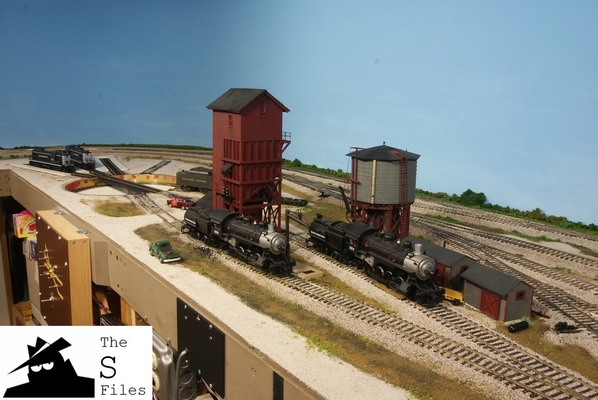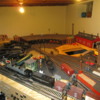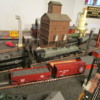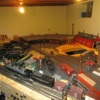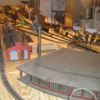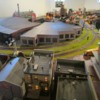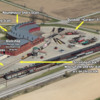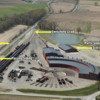Can anyone point me in the right direction? Post your turntable/roundhouse pictures!
Replies sorted oldest to newest
IF you are running steam, you probably want to include a water tower at the minimum. Steam used more water than coal. If you put in a coaling tower, you probably should include an ashpit. Crescent locomotive works makes a very nice ashpit and hoist model. He will customize it to your track.
If this is a small yard at the end of a line, maybe the table stands alone, or has a water tower nearby. If this yard represents a division point or large terminus, it should have all the servicing facilities. Below is a schematic of my yard and engine terminal. the track closest to the back of the roundhouse track is a stub end yard lead to allow working the yard without blocking the main.

Attachments
Attachments
It was the Greenport terminal on the LIRR mainline. The pit and bridge remain. The area where the roundhouse was is now a commuter parking lot and bus stop. My home town, Shelter Island, is in the background across the water. In the 1950's and '60's the power to turn the table was provided by compressed air from the Diesels. A typical locomotive was the F-B C-liner.
The photo was taken from the roof of the water tower, also no longer in existence. There are two tracks into the passenger platform area. Neither goes out onto what we locals still call the "railroad dock" which was used to on- and off-load freight directly to boats. Fish from commercial boats to the markets in the city, and famous Long Island potatoes and other vegetables to New England.
The passenger station, seen at the far end of the string of coaches, still stands, and has been re-purposed into a maritime museum.
If you do use a turntable, try to make the leads into the table long enough to have engine servicing facilities, such as coaling tower, water tower, sanding tower, and maybe an ash pit.
@CAPPilot posted:If you do use a turntable, try to make the leads into the table long enough to have engine servicing facilities, such as coaling tower, water tower, sanding tower, and maybe an ash pit.
How would these connect? As branches of the roundhouse or as part of the yard track?
Ideally, a turntable shouldn't have an approach directly off a running line, but our layouts often can't afford the space. John Allen's original G&D had a siding arrangement with one leg to the turntable. Its a neat space-saver and was adapted for O Gauge with crossing sidings here: https://ogrforum.ogaugerr.com/...january-issue-of-ogr
@greg_08 posted:How would these connect? As branches of the roundhouse or as part of the yard track?
They would be between the turntable and the yard lead or mainline, so the engines could be serviced after and before going into the roundhouse. Ideally two tracks to the turntable.
I think it's pretty safe to say that most facilities were built to suit the "local" environment. I'd look at all the examples I could (both real and model wise) and choose from what I liked/fit my layout.
https://www.google.com/search?...g&sclient=psy-ab
Good luck
Simon
Here's what my area looks like. I came off the mainline in a couple of spots and ended up with three servicing tracks that the turntable also utilizes. These pictures were taken at many different times. The turntable serves a total of 26 tracks, 14 of them now lead into two roundhouses. I am happy with what I did.
Attachments
The turntable at the SP facilities at Dunsmuir, CA was only a few feet from the mainline. Go to google earth and you can see it today still in use though most of the trackwork and buildings have been removed or replaced.
This site has pictures of how it looked in its heyday.
http://www.snowcrest.net/photobob/historical.html
Another thing of note. The roundhouse was originally built to service engines likely no longer than 4-6-0s and 2-8-0s. Then larger stalls were added to one end and the turntable lengthened to accomodate longer engines. Finally when the mallets and articulateds came a shed was built. The turntable was too short to turn those engines but it was used to provide a through path to the sheds. Something to consider if you don't have room for a huge turntable.
A lot was fit into a very small area.
Pete
@Norton posted:The turntable at the SP facilities at Dunsmuir, CA was only a few feet from the mainline. Go to google earth and you can see it today still in use though most of the trackwork and buildings have been removed or replaced.
This site has pictures of how it looked in its heyday.
http://www.snowcrest.net/photobob/historical.html
Another thing of note. The roundhouse was originally built to service engines likely no longer than 4-6-0s and 2-8-0s. Then larger stalls were added to one end and the turntable lengthened to accomodate longer engines. Finally when the mallets and articulateds came a shed was built. The turntable was too short to turn those engines but it was used to provide a through path to the sheds. Something to consider if you don't have room for a huge turntable.
A lot was fit into a very small area.
Pete
A point well taken about turntable size. Because my table is only 28" I had to do the same thing the SP did, and put my mallets as "run thru"s as well onto the table and straight across to waiting tracks.
In my mind, the most important thing to think about when positioning the turntable is the route the locomotives will take to access it. You mention you are incorporating it into a yard. So, you need to consider:
- When a train entering the yard comes to rest, where is the locomotive? The locomotive needs to be able to move from that spot to the turntable.
- When a train is prepared to exit the yard, at the moment of departure, where is the locomotive? The locomotive needs to be able to move from the turntable to that spot.
In both cases, you need to be able to move the locomotive to/from the turntable without having to move any other locomotives or cars out of its way. It needs a clear path. And, if your layout has more than one train moving at a time, the locomotive also needs to be able to make its move without entering a track (or block) which is already in use by the other train.
Real railroads, of course, have to think about these same things. So any solution you come up with that satisfies these conditions will be "realistic" by default!
@greg_08 posted:Can anyone point me in the right direction?
I see what you did, there ![]() .
.
@nickaix posted:I see what you did, there.
HAH
I didn't pick up on that until you said that.
What would you do with this sort of rough draft (blue boxes are doors that need an open route).
I am also trying to come up with some solutions for the right hand side. Min curve entire layout is O72. Max is O106 maybe? GG flex and Ross switches. Space is roughly 17ft x 32 ft
Draft:

Attachments
A turntable serves two purposes...
- To turn locomotives.
- To position locomotives for entry into a roundhouse stall where repairs were performed.
A good lesson on how to lay out an engine servicing facility can be seen at the Age of Steam Roundhouse in Sugarcreek, Ohio. Click on the photos to enlarge them.
Attachments
Thank you! Very helpful.
Great Question, great thread, turntables and roundhouses are really good focal points on most layouts, and in O guage they take up a relatively large footprint. In reality, this project can be a little pricy, but other than price, should be planned before the layout is built. The smallest turntable that’s functional is the Atlas O TT, and it’s basically for diesels, small steam. The Question, how can I realistically add a turntable to your layout, strictly depends on the size of your layout area. Good luck, and by all means get a turntable for your enjoyment. Happy Railroading 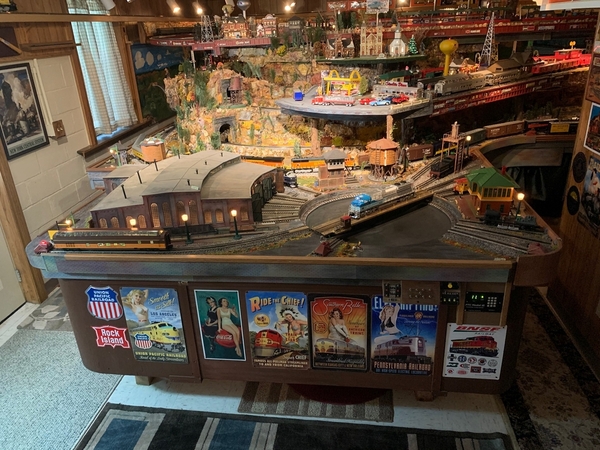
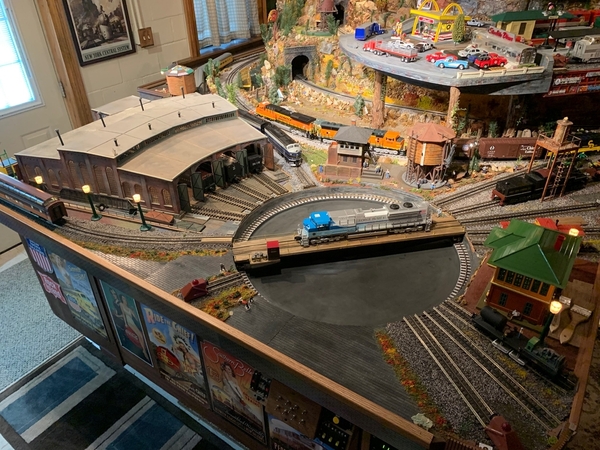

Attachments
Larry your layout never ceases to amaze me. In this turntable area alone I love the accessibility of the trains by keeping the turntable at the edge. The rounded table corners are great and the vertical stacking of your layout is really impressive.





